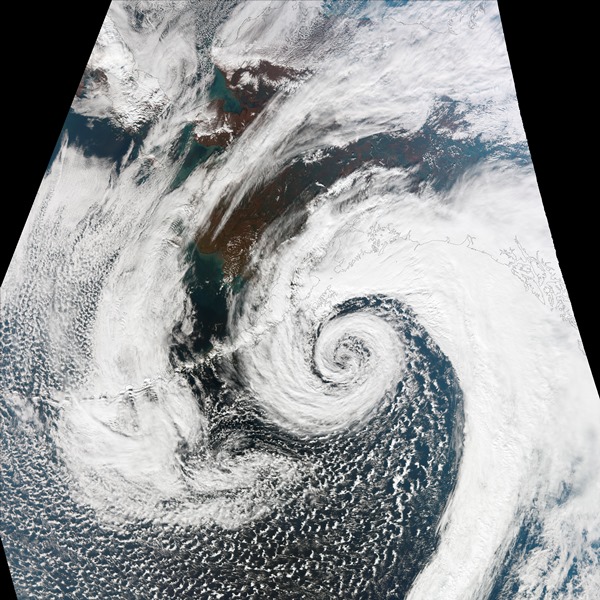This year’s Atlantic hurricane season offers a stark reminder of the power of oceans over weather. But ocean influences aren’t limited to the Atlantic. Last winter, rain and snow drenched California, much of it the result of “atmospheric rivers,” storms that channeled water from the Pacific straight to the Sierra and across the West. Torrents of rain flooded cities and damaged dams, but also helped end five years of drought in the Golden State.
In a region that relies heavily on snowmelt to supply homes and irrigate fields, Western water managers need to know how much precipitation they can expect in the coming years. While scientists understand the broad strokes of how wet and dry periods are driven by energy traveling through the atmosphere, new research is refining that understanding – something that may ultimately help officials trying to fill the reservoirs and rivers of the West.
The world’s oceans and its atmosphere are tightly connected. Because of that link, and global forces like wind and ocean currents that shuttle energy through the atmosphere, far-flung ocean conditions can influence weather. Warm water and thunderstorms in the tropical Pacific, for example, can cause a surge in winter storm activity from Alaska to California. When the ocean heats up in the tropical Pacific, storms build above the water. “Imagine these huge thunderstorm clouds as they rise up – it’s almost like they’re punching the atmosphere,” says Erich Osterberg, a climatologist at Dartmouth College. The force of those punches creates waves in the atmosphere.
Those pressure waves undulate out toward the poles, creating areas of high pressure where they peak, and areas of low pressure – associated with precipitation – where they dip. A wintertime trough of low pressure in the Gulf of Alaska, called the Aleutian Low, often forms. When that low-pressure system is more intense, the severity of the winter storm season from Alaska to California goes up, too.
The Aleutian Low has been intensifying for at least the past 50 years, stirring up more stormy weather. Scientists weren’t sure when the modern escalation started or if similar periods have occurred in the past. To find out, Osterberg and his colleagues analyzed the amount of salt in layers of glacier ice from Alaska’s Denali National Park. Saltier layers correspond to years with more intense winter storm activity, when tempests sloshed more seawater onto the ice. The researchers found that the modern intensification, which is the most extreme in 1,200 years, began in the early 1700s. The source of the earliest warming is not yet clear, though human-induced climate change is responsible for recent warming. “This is not just a natural cycle,” Osterberg says. The current period of intensification “really is truly out of the normal range.”
That history hints at how the Aleutian Low – and the storms it causes – might behave in the future. But many of the scientific models forecasting the effects of climate change don’t accurately capture the Aleutian Low’s intensity, Osterberg says. That means current projections may underestimate future storm activity along the Pacific coast. “There’s a lot of room for improvements to these models to really understand what’s going to happen in Alaska or California in terms of increased storms or drought in the future,” he says.

A satellite image of the Aleutian Low forming over Southwest Alaska. These low-pressure systems go on to impact winter weather and water all the way down to California. (NASA)
To improve short-term predictions, other scientists are incorporating information about ocean conditions into models that can predict wet and dry periods over the next few years.
One multi-year model, recently developed by a team of researchers led by Yoshimitsu Chikamoto at Utah State University, realistically represents droughtin the western United States, as measured by soil moisture and fire season length, for about two years out. The model incorporates long-term changes to the atmosphere caused by human activity and natural sources like volcanoes, but it also includes the temperature difference between the Atlantic and Pacific oceans. That relationship appears to influence conditions on land: When the Pacific is cooler than the Atlantic, the West generally experiences drier conditions, and when the Pacific is warmer than the Atlantic, the West is wetter.
That factor doesn’t operate in isolation, however. Other oscillations in oceanic and atmospheric conditions, like the weather phenomena El Niño and La Niña, also affect drought in the West. Those elements can interact in complex ways. “It is a little bit naive to rely on one particular index to say you know what’s going to happen in any one particular year in any one particular region,” says Robert Gillies, a professor at Utah State University and Utah’s state climatologist.
While multi-year forecasts can’t foresee the exact date of a future storm, they can indicate general conditions: whether the West should expect a wetter-than-average period or a particularly dry period. Government agencies will likely start incorporating them into their forecasts within the next several years. Knowing what to expect could help water managers in California and across the West brace for the region’s weather extremes, from the deluges of last winter to years of drought.
This article originally appeared on High Country News.
